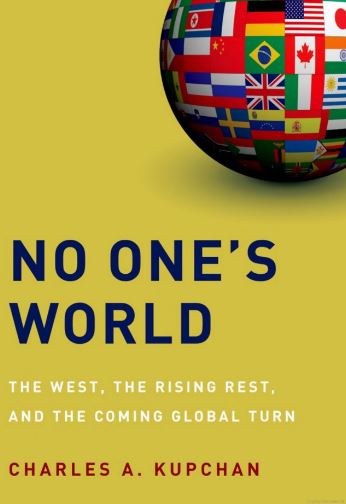
In the book No One’s World, as the title suggests, no country, region, or political model will dominate in the 21st century. “It will belong to no one,” wrote the author, Charles A. Kupchan. In his view, a new global order is in the making consisting of a revived West and emerging powers derived from various polities. The notable variants of autocracy include China-led communal autocracy, Russian-led paternal autocracy, and tribal autocracy such as the sheikdoms of the Persian Gulf. Iran is a prime example of theocracy; African countries make up the club of strongmen; and populism dominates Latin American politics.
I’d imagine the surprising response, perhaps in disbelief, that the author might have received when his book first hit the shelf in 2012. It was so unconventional in the West to give a nod to the non-democratic states like China and Russia. But if we put down our skepticism and judgment to read the book, there’s more truth to Kupchan’s vision of a no one’s world, even when we’re in 2020 bracing for crises one after another. There has been a lot that’s happened in the last eight years. The rising powers that appeared in Kupchan’s book all have faced some sorts of obstacles in their path of development.
To name a few: the failed Turkish coup in 2016 and the following purge targeting its intellectuals have further strengthened President Erdoğan’s grip of power. His latest move to covert the UNESCO World Heritage-recognized great cathedral of Hagia Sophia into a mosque and an Istanbul’s Chora church museum to a mosque has bolstered his religious nationalism. In 2016, India introduced an abrupt and drastic currency reform under Modi, banning the 500 rupee ($7.50) and 1,000 rupee ($15) notes which made up about 86% of all cash in circulation. Brazil, Russia and South Africa have been in recession. Growth has slowed in China and India. Back in 2001 following the 9/11 attacks, Goldman Sachs coined the term “BRIC” in its report, “Build Better Global Economic BRIC,” with a sanguine outlook for Brazil, Russia, India and China to reshape the world economy. South Africa joined the club in 2010. Today, facing another world economy slowdown as a result of the covid pandemic, the BRICS nations act as symbols rather than something that challenges the IMF. Even the coinage inventor Jim O’Neill said in his hindsight interview that it could have been “IC” rather than “BRICS.”
The term “emerging powers” is contentious as the Oxford Bibliographies explains: “To be described as an emerging power, a country usually needs to be large (both regarding geographic extension and population, though not always, as the case of Japan shows) and poorer on a per capita basis than industrialized countries, though there is no clear definition of where a country ceases to ‘emerge.’” In Kupchan’s No One’s World, BRICS came up a number of times. The author expounded his argument on emerging powers attaining modernity on a non-conventional path if we perceive the rise of the West as conventional. To steer away from the beleaguered BRICS and make the grouping of “emerging powers” current and inclusive, I’m using World Bank’s acronym, EMDEs (emerging market and developing economies), instead.
While EMDEs are focusing on development and perhaps consolidation of power as well, the United States and the United Kingdom share the same detrimental fate—political polarization and xenophobia. Brexit is a painful historical lesson of xenophobia. So is the humanitarian crisis at the US border. And yes, the 45th president of the U.S. has upended foreign policy, making Kupchan’s No One’s World more of a reality than a fantasy. Despite all that, if we let the global stage pause at 2012, the author’s viewpoint is coherent with what then was the long-standing theme of U.S. foreign policy, that is, pluralism. The pluralistic world order calls for international cooperation and “more geopolitical responsibility,” as Kupchan put it, in response to pressing global issues. Kupchan suggested that “multilateral cooperation offers the most effective means of combating nuclear proliferation, terrorism, cyber-attack, and other threats. (Kupchan, p.173)”
Climate change is a great “threat multiplier” in Sherri Goodman’s coinage. As of this writing, Death Valley in Southern California reached 130 degrees Fahrenheit this summer (August 17), marking the hottest recorded temperature on Earth since 1931. The Greenland Ice Sheet is melting fast to a point that scientists believe it is unlikely to stop from disintegrating. If only all nations prioritized climate change as a national security issue, heads of state would be able to learn that almost all domestic issues that they touted they would tackle are interconnected with climate change.
Kupchan further explained how to facilitate regional devolution, which reminded me of systems leadership that requires collaboration, coalition-building and systems insight to mobilize action across a decentralized network. He wrote, “The diffusion of global power ultimately means the diffusion of international responsibility—from the Atlantic community of democracies to a broad array of states in good standing in all quarters of the globe. A new distribution of power necessitates a new distribution of responsibility, and effectively tackling many of today’s challenges requires broad cooperation across region and regime type. (Kupchan, p.197)”
If only the pandemic would quicken action to fulfil Kupchan’s call for a new distribution of responsibility. How would the world look if EMDEs were given more mic time at the UN assembly, more roles to play in decision making posts of intergovernmental organizations, and more leadership education? Will the big industrialized countries together with China and Russia be willing to delegate authority to smaller countries and open the doors for EMDEs to weigh in? Even among big nations, will they share information on equal footing without peppering biases and hostility? Despite all the controversy, many Americans work at WHO. When China informed WHO about the novel coronavirus in early January, the WHO staff, regardless of which countries they represented, would have known about that information. Since bad news always travels fast, how could we not think that the US representatives at WHO would have simultaneously informed the public health agencies in the US? The US touts open information and free press. How long would it take for such crucial piece of public health warning to reach the shores of the US? The US government’s delay of response to covid is a fact. The rest has become history. And we’re living in it.
We’ve heard a lot of the word “unprecedented” in the US politics of late, and yet the status quo remains. I’m intrigued to learn from No One’s World that the US “has been sacrificing the lives of its soldiers and spending about $100 billion annually to bring stability to Afghanistan. (Kupchan, p.102)” No doubt that the US has become more militarized after 9/11 attacks. How many lives would a budget of $100 billion annually benefit domestically? Can we infer that the hard stance toward allies and adversaries from the incumbent administration is a strategy for the hawks to maintain their status quo left over from the peak of military spending? Under the current administration, establishing the US Space Force, resuming arms sales to Taiwan, and building the US-Mexico border wall are all costly deals that benefit only some interest groups. Space exploration should be regulated as an inclusive endeavor for humanity, not as a competition ground for big countries. Furthermore, if we look at how costly today’s elections are in the US, fighting for democracy indeed is costly, both economically and emotionally. No wonder a seasoned salesman was elected to occupy the White House. No wonder the average age of incumbent US Senators is 61.8 years, among the oldest in US history. Political mobility has reached a stalemate. Kupchan may need to write a sequel for young prospect leaders to barely survive, let alone breaking the norms, in no one’s world.
Systemic problems are seen in every corner of the world. I’ll explain in part two why neither the US nor China should be afraid of one another if they value the fact that cooperation trumps isolation in no one’s world. (I thought I could have avoided the word “trump”. Funny that I said it at last.)
